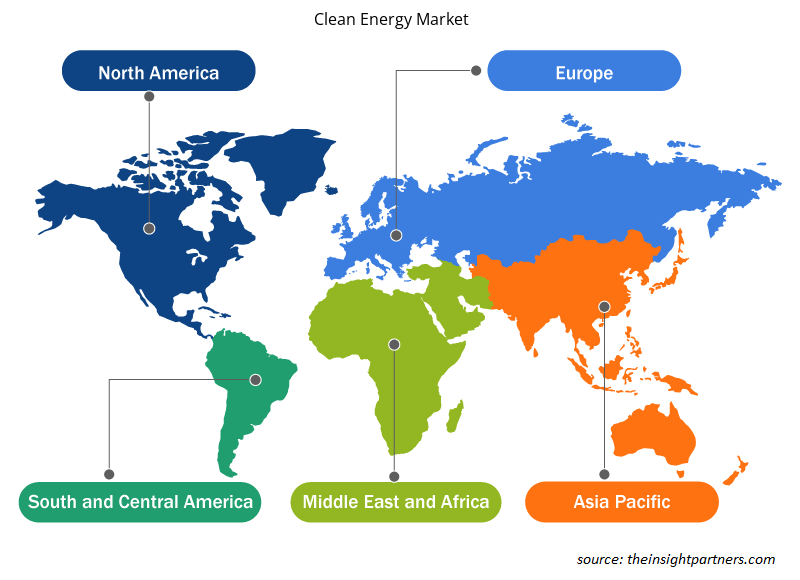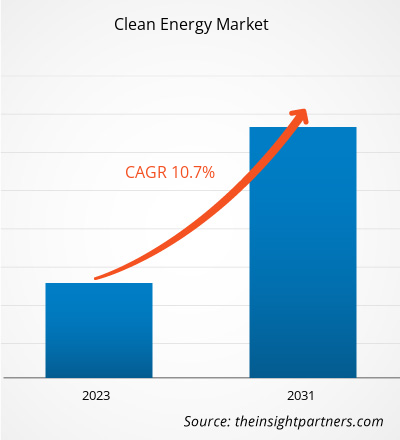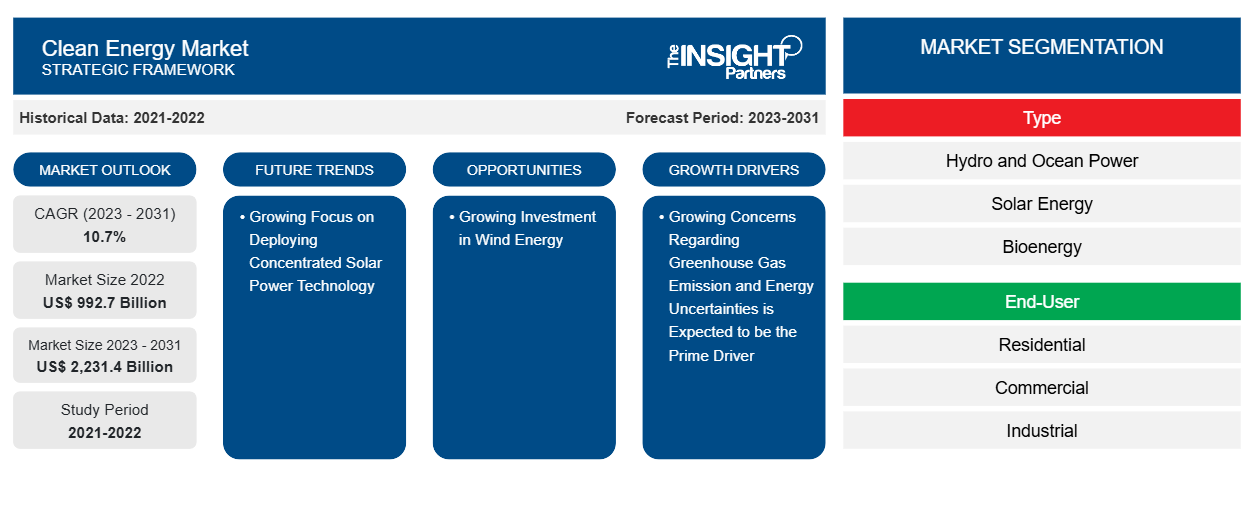Das Marktvolumen für saubere Energien soll von 992,7 Milliarden US-Dollar im Jahr 2022 auf 2.231,4 Milliarden US-Dollar im Jahr 2031 anwachsen. Für den Zeitraum 2023–2031 wird ein durchschnittliches jährliches Wachstum von 10,7 % erwartet. Der zunehmende Fokus auf die Reduzierung der Treibhausgasemissionen, die zunehmende Betonung erneuerbarer Energiequellen zur Förderung der Nachhaltigkeit und das zunehmende Interesse am Umweltschutz werden voraussichtlich weiterhin die wichtigsten Trends auf dem Markt bleiben.CAGR of 10.7% during 2023–2031. Growing focus on reducing GHG emissions, increasing emphasis on renewable energy sources for promoting sustainability, and rising concern toward environment protection are likely to remain key trends in the market.
Marktanalyse für saubere Energie
Die sich weltweit ändernden Energieumstände schaffen eine Nachfrage nach nachhaltigeren Energiequellen, um den steigenden Energiebedarf zu decken. Der steigende Energiebedarf zeigt die Bedeutung sauberer Energiequellen. Steigende Energiepreise und Versorgungsunsicherheiten aufgrund verschiedener geopolitischer Herausforderungen werden voraussichtlich das Wachstum des Marktes für saubere Energie im Prognosezeitraum vorantreiben. Die Nutzung sauberer Energie trägt dazu bei, die negativen Umweltauswirkungen herkömmlicher Energiequellen wie Kohle und Öl zu verringern. Daher haben die Regierungen mehrerer Länder weltweit Steueranreize und günstige Richtlinien eingeführt, um die Nutzung sauberer Energiequellen zu fördern, was der wichtigste Antriebsfaktor für den Markt ist.
Marktübersicht für saubere Energie
Mit der wachsenden Bevölkerung und Industrialisierung steigt auch der Energiebedarf auf globaler Ebene. Dies hat den Bedarf an alternativen Energiequellen erhöht, da traditionelle Energieressourcen wie fossile Brennstoffe zur Umweltverschmutzung führen. Saubere Alternativen wie Solar- und Windenergie dämmen enorme Kohlenstoffemissionen und ihre negativen Auswirkungen auf die Umwelt ein und tragen dazu bei, Energieangebot und -nachfrage auszugleichen. Daher treiben der Anstieg der Entwicklung des Sektors für erneuerbare Energien und unterstützende Regierungsinitiativen zur Verwendung eines nachhaltigen Ansatzes zur Reduzierung der Kohlenstoffemissionen die Investition in saubere Energiequellen wie Wind, Solar, Geothermie und Wasserkraft an.
Passen Sie diesen Bericht Ihren Anforderungen an
Sie erhalten kostenlose Anpassungen an jedem Bericht, einschließlich Teilen dieses Berichts oder einer Analyse auf Länderebene, eines Excel-Datenpakets sowie tolle Angebote und Rabatte für Start-ups und Universitäten.
-
Holen Sie sich die wichtigsten Markttrends aus diesem Bericht.Dieses KOSTENLOSE Beispiel umfasst eine Datenanalyse von Markttrends bis hin zu Schätzungen und Prognosen.
Treiber und Chancen auf dem Markt für saubere Energie
Wachsende Besorgnis über Treibhausgasemissionen und Energieunsicherheiten
Die Weiterentwicklung des Energiesystems nach dem Pariser Abkommen, das 2015 ins Leben gerufen und 2016 in Kraft getreten ist, hat die Nutzung sauberer Energiequellen zur Senkung der Kohlenstoffemissionen gefördert. Ein wesentlicher Beitrag zu den Treibhausgasemissionen, die zum Klimawandel führen, ist die Stromerzeugung durch fossile Brennstoffe. Die Nutzung sauberer Energiequellen wie Sonne, Wind, Wasser und Geothermie nimmt zu, da die Sorge um nachhaltigere und umweltfreundlichere Energiealternativen zunimmt, die Bedenken hinsichtlich des Klimawandels zunehmen und staatliche Initiativen zur Förderung der Nutzung sauberer Energie weltweit unterstützen. Die Regierungen mehrerer Volkswirtschaften erkennen die Bedeutung der Umstellung auf saubere Quellen, um die zukünftigen Ziele der Erreichung niedriger bis null Kohlenstoffemissionen zu erreichen. So hat sich die US-Regierung zum Ziel gesetzt, die Netto-Treibhausgasemissionen bis 2030 im Vergleich zum Stand von 2005 um ~50–52 % zu senken und bis 2050 Netto-Null-Emissionen zu erreichen. Ebenso hat sich die deutsche Regierung das Ziel gesetzt, ihre Kohlenstoffemissionen bis 2030 im Vergleich zum Stand von 1990 um ~65 % zu senken.GHG emissions by ~50–52% compared to 2005 levels by 2030 and attain net zero emissions by 2050. Likewise, the German government has fixed a target to lower its carbon emissions by ~65% compared to 1990 levels by 2030.
Aufgrund der zunehmenden Energieunsicherheit in Europa aufgrund des Russland-Ukraine-Kriegs erkannten die Regierungen mehrerer Länder das Potenzial im Inland erzeugter sauberer Energien. Der Markt für saubere Energie umfasst Energiequellen, vor allem Wind, Wasserkraft, Geothermie und Solarenergie. Daher wirken die wachsenden Bedenken hinsichtlich Treibhausgasemissionen und Energieunsicherheiten als Haupttreiber für den Markt für saubere Energie.
Steigende Investitionen in Windenergie zur Schaffung alternativer Energiequellen
Windenergie, die vor allem dazu beiträgt, den steigenden Energiebedarf auf umweltfreundliche Weise zu decken, entwickelt sich zu einer wichtigen Alternative zu fossilen Brennstoffen. Darüber hinaus konzentrieren sich die Regierungen verschiedener Länder auf Investitionen in Onshore- und Offshore-Windprojekte , um die Abhängigkeit von fossilen Brennstoffen zu verringern und so die Kohlenstoffemissionen und ihre toxischen Auswirkungen auf die Umwelt zu mildern. Offshore-Windprojekte gelten als effizienter als Onshore-Windparks, da sie gleichmäßiger und schneller sind und keine physischen Störungen vom Land aus auftreten. Die zunehmende Zahl von Offshore-Windprojekten ist auch ein wichtiger Wachstumsfaktor für den Markt für saubere Energie weltweit.
Segmentierungsanalyse des Marktberichts für saubere Energie
Die Schlüsselsegmente, die zur Ableitung der Marktanalyse für saubere Energie beigetragen haben, sind Typ und Endbenutzer.
- Nach Art wurde der Markt für saubere Energie in Wasser- und Meeresenergie, Solarenergie, Bioenergie, Geothermie und Windenergie unterteilt. Das Segment Wasser- und Meeresenergie hatte im Jahr 2023 den größten Marktanteil.
- Nach Endverbraucher wurde der Markt in Wohn-, Gewerbe- und Industrieimmobilien segmentiert. Das Wohnsegment dominierte den Markt im Jahr 2023.
Analyse der Marktanteile sauberer Energie nach geografischer Lage
Der geografische Umfang des Berichts zum Markt für saubere Energie ist hauptsächlich in fünf Regionen unterteilt: Nordamerika, Europa, Asien-Pazifik, Naher Osten und Afrika sowie Süd- und Mittelamerika.
Der asiatisch-pazifische Raum dominierte 2023 den Markt für saubere Energie. Die wachsende Bevölkerung und der steigende Energiebedarf wirken als wichtige Antriebsfaktoren für den Markt für saubere Energie im asiatisch-pazifischen Raum. Darüber hinaus wird der zunehmende Fokus der Regierung auf die Einführung unterstützender Maßnahmen und Richtlinien zur Verringerung der Abhängigkeit von fossilen Brennstoffen und zur Reduzierung der Kohlenstoffemissionen höchstwahrscheinlich den Markt für saubere Energie in der Region ankurbeln. Zunehmende Umweltverschmutzung und schwerwiegende Auswirkungen des Klimawandels sind große Sorgen, die den Bedarf an sauberen alternativen Energiequellen zur Reduzierung der Nutzung fossiler Brennstoffe fördern. So bietet die indische Agentur für die Entwicklung erneuerbarer Energien beispielsweise zinsgünstige Darlehen für die Entwicklung förderfähiger Projekte für erneuerbare Energien im Land an. Indien hat sich zum Ziel gesetzt, bis 2030 50 % der installierten elektrischen Leistung aus erneuerbaren Energien zu gewinnen und bis 2070 Netto-Null-Kohlenstoffemissionen zu erreichen. Darüber hinaus hat die Regierung 2022 einen Aktionsplan „Mission 500 GW“ eingeführt, um das Gesamtziel für erneuerbare Energien zu erreichen.
Regionale Einblicke in den Markt für saubere Energie
Die regionalen Trends und Faktoren, die den Markt für saubere Energie im Prognosezeitraum beeinflussen, wurden von den Analysten von Insight Partners ausführlich erläutert. In diesem Abschnitt werden auch Marktsegmente und Geografie für saubere Energie in Nordamerika, Europa, im asiatisch-pazifischen Raum, im Nahen Osten und Afrika sowie in Süd- und Mittelamerika erörtert.

- Erhalten Sie regionale Daten zum Markt für saubere Energie
Umfang des Marktberichts für saubere Energie
| Berichtsattribut | Details |
|---|---|
| Marktgröße im Jahr 2022 | 992,7 Milliarden US-Dollar |
| Marktgröße bis 2031 | 2.231,4 Milliarden US-Dollar |
| Globale CAGR (2023 - 2031) | 10,7 % |
| Historische Daten | 2021-2022 |
| Prognosezeitraum | 2023–2031 |
| Abgedeckte Segmente |
Nach Typ
|
| Abgedeckte Regionen und Länder |
Nordamerika
|
| Marktführer und wichtige Unternehmensprofile |
|
Dichte der Akteure auf dem Markt für saubere Energie: Die Auswirkungen auf die Geschäftsdynamik verstehen
Der Markt für saubere Energie wächst rasant. Dies wird durch die steigende Nachfrage der Endverbraucher aufgrund von Faktoren wie sich entwickelnden Verbraucherpräferenzen, technologischen Fortschritten und einem größeren Bewusstsein für die Vorteile des Produkts vorangetrieben. Mit der steigenden Nachfrage erweitern Unternehmen ihr Angebot, entwickeln Innovationen, um die Bedürfnisse der Verbraucher zu erfüllen, und nutzen neue Trends, was das Marktwachstum weiter ankurbelt.
Die Marktteilnehmerdichte bezieht sich auf die Verteilung der Firmen oder Unternehmen, die in einem bestimmten Markt oder einer bestimmten Branche tätig sind. Sie gibt an, wie viele Wettbewerber (Marktteilnehmer) in einem bestimmten Marktraum im Verhältnis zu seiner Größe oder seinem gesamten Marktwert präsent sind.
Die wichtigsten auf dem Markt für saubere Energie tätigen Unternehmen sind:
- Xcel Energy Inc.
- EDF Energie
- Siemens Energy AG
- Enel SpA
- Andritz AG
Haftungsausschluss : Die oben aufgeführten Unternehmen sind nicht in einer bestimmten Reihenfolge aufgeführt.

- Überblick über die wichtigsten Akteure auf dem Markt für saubere Energie
Neuigkeiten und aktuelle Entwicklungen zum Markt für saubere Energie
Der Markt für saubere Energie wird durch die Erhebung qualitativer und quantitativer Daten aus Primär- und Sekundärforschung bewertet, die wichtige Unternehmensveröffentlichungen, Verbandsdaten und Datenbanken einschließen. Nachfolgend sind einige der Entwicklungen auf dem Markt für saubere Energie aufgeführt:
- Canadian Solar Inc. gab bekannt, dass die Stadtverwaltung der Stadt Yangzhou in der chinesischen Provinz Jiangsu eine mehrjährige Investitionsvereinbarung mit ihrer mehrheitlich in ihrem Besitz befindlichen Tochtergesellschaft CSI Solar Co Ltd unterzeichnet hat. Der Vereinbarung zufolge plant CSI Solar, die Kapazität des Industrieparks für saubere Energie in Yangzhou zur Herstellung vertikal integrierter hocheffizienter Wafer, Zellen und Module sowie Batteriesysteme zu erweitern. (Quelle: Pressemitteilung/Unternehmenswebsite/Newsletter, Januar 2023)
- Composites, Inc. (TPI) (Nasdaq: TPIC), ein globales Unternehmen, das sich auf innovative und nachhaltige Lösungen konzentriert, gab bekannt, dass es seine Lieferverträge mit GE Renewable Energy bis 2025 verlängert hat. GE und TPI planen außerdem eine Zusammenarbeit bei GEs Rotorblatttypen der nächsten Generation, einschließlich der Möglichkeit, im Jahr 2023 zusätzlich zu den neun Produktionslinien, die GE mit TPI in Betrieb hat, insgesamt weitere Produktionslinien in Betrieb zu nehmen. (Quelle: Pressemitteilung/Unternehmenswebsite/Newsletter, Januar 2023)
Bericht zum Markt für saubere Energien – Abdeckung und Ergebnisse
Der Bericht „Marktgröße und Prognose für saubere Energie (2021–2031)“ bietet eine detaillierte Analyse des Marktes, die die folgenden Bereiche abdeckt:
- Größe und Prognose des Marktes für saubere Energie auf globaler, regionaler und Länderebene für alle wichtigen Marktsegmente, die im Rahmen des Berichts abgedeckt sind
- Markttrends für saubere Energie sowie Marktdynamik wie Treiber, Einschränkungen und wichtige Chancen
- Detaillierte PEST/Porters Five Forces- und SWOT-Analyse
- Analyse des Marktes für saubere Energie, einschließlich wichtiger Markttrends, globaler und regionaler Rahmenbedingungen, wichtiger Akteure, Vorschriften und aktueller Marktentwicklungen
- Branchenlandschaft und Wettbewerbsanalyse, einschließlich Marktkonzentration, Heatmap-Analyse, prominenten Akteuren und aktuellen Entwicklungen auf dem Markt für saubere Energie
- Detaillierte Firmenprofile
- Historische Analyse (2 Jahre), Basisjahr, Prognose (7 Jahre) mit CAGR
- PEST- und SWOT-Analyse
- Marktgröße Wert/Volumen – Global, Regional, Land
- Branchen- und Wettbewerbslandschaft
- Excel-Datensatz
Aktuelle Berichte
Erfahrungsberichte
Grund zum Kauf
- Fundierte Entscheidungsfindung
- Marktdynamik verstehen
- Wettbewerbsanalyse
- Kundeneinblicke
- Marktprognosen
- Risikominimierung
- Strategische Planung
- Investitionsbegründung
- Identifizierung neuer Märkte
- Verbesserung von Marketingstrategien
- Steigerung der Betriebseffizienz
- Anpassung an regulatorische Trends























 Kostenlose Probe anfordern für - Markt für saubere Energie
Kostenlose Probe anfordern für - Markt für saubere Energie